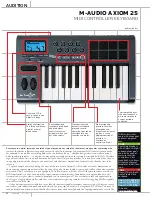
[F7]
=
F7 key
[F8]
=
F8 key
[F9]
=
F9 key
[F10] =
F10 key
[F11] =
F11 key
[F12] =
F12 key
[Space]=
Space Bar
[ ]
=
Space Bar
[Print] =
Print Screen [Scroll] =
Scroll Lock
[Pause] =
Pause/Break [Num] =
Num Lock
[Insert] =
Insert Key
[Home]=
Home key
[PageUp]=
Page Up
[PageDn]=
Page Down
[Delete]=
Delete key
[End] =
End key
[Up] =
Up Arrow
[Down] =
Down Arrow
[Left] =
Left Arrow
[Right] =
Right Arrow
[LWin] =
Left Windows [RWin] =
Right Windows
[Win] =
Win Apl
[Enter] =
Enter
[BS]
=
Backspace
[CAPS] =
Caps Lock
[Tab] =
Tab key
[(N)1] =
1/End
[(N)2] =
2/Down
[(N)3] =
3/PgDn
[(N)4] =
4/Left
[(N)5] =
5
[(N)6] =
6/Right
[(N)7] =
7/Home
[(N)8] =
8/Up
[(N)9] =
9/PgUp
[(N)0] =
0/Ins
[(N).] =
./Del
[(N)Enter]= Enter
[(N)+] =
+
[(N)-] =
-
[(N)*] =
*
[(N)/] =
/
Note: the (N) with a key definition indicates that the key being
emulated is the one from the numeric keypad section of the key-
board.
When saving a configuration file, it must be saved as a text file only.
The text file can be created from virtually any document editing
program. The file type to use for saving is typically referred to as
a “.txt” file in ANSI format or “ASCII DOS Text” depending on the
program used to create the file. Refer to the sample configuration
file on the CD included with the KE72.
11
Using the KE72 Serial Port
Responses from the activation of inputs may be directed to the
serial port instead of producing keystrokes as described in the
earlier configuration file section. In addition to that function, the
KE72 serial port may be used in several other modes as well.
Serial Data to Keystroke Modes -
The KE72 features two different serial data to keystroke conversion
modes. One mode accepts direct ASCII characters while the
second mode accepts “key numbers” which command the up and
down state of any key. The ASCII mode is the default mode at
power up and reset, but the mode may be changed and identified
by special one byte serial commands shown later in this section.
The ASCII to Keystroke mode
will accept printable ASCII
characters and translate them into keystrokes on the PC. If an
ASCII “A” is sent to the serial port, the KE72 will produce the
required keystrokes to produce an upper case “A”. The KE72
responds with a “!” character after each byte is received in this
mode. Always wait for the “!” acknowledgement before sending
additional communication to the serial port. Any characters sent to
the KE72 which are not printable ASCII characters are ignored.
The Key Number to Keystroke
mode
allows the commanding
of the up and down state of any key on the keyboard. In this
mode, each key on the keyboard is represented by a number (See
Appendix F for the key number table). Sending the key number to
the serial port results in a “down” key state for the corresponding
key. Sending the same code +128 decimal results in the “key
up” message being generated for that key. Use this key number
mode to emulate keystrokes and keystroke combinations such as
Ctrl+F1, etc. Note that “key down” refers to the press of a key
and “key up” refers to the release of a key. Always send a key up
message for a key that had previously been sent as a key down
16













































